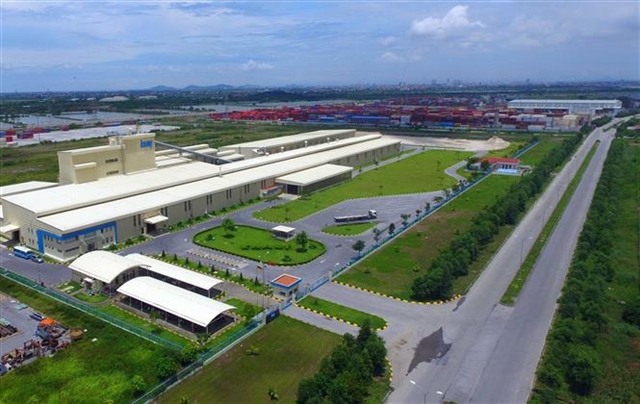 Economy
Economy

The industrial real estate sector is considered a bright spot this year, and property businesses with industrial parks are expected to benefit from increased demand and rental prices.

|
| A view of the Đình Vũ Industrial Park in Hải Phòng City. In 2022 and 2023, the industrial land supply is expected to increase by over 7,000 ha for both Northern and Southern regions. Photo VNA/VNS Photo |
HÀ NỘI — The industrial real estate sector is considered a bright spot this year, and property businesses with industrial parks are expected to benefit from increased demand and rental prices.
According to SSI Securities Inc., public investment in improving the infrastructure connecting industrial parks is promoting recovery of demand of rented land in the industrial parks.
Infrastructure projects that will create convenient traffic connecting industrial parks include the expressway projects of Biên Hòa - Vũng Tàu, Dầu Giây - Phan Thiết, North - South, Thị Vải - Cái Mép port and Gemalink port.
Cushman and Wakefield, a leading global real estate services firm, reported Việt Nam continues to be an attractive destination for industrial real estate investors due to a stable growth rate, an export-oriented economy, an increase in free trade agreements, a young workforce, preferential investment policies and strategic location.
With favourable government incentives, competitive labour costs, a stable political environment, a positive economic outlook and free trade agreements, Việt Nam has also become favoured by foreign investors moving out of China.
To seize this opportunity, in early 2022, information about the expansion of the land fund has been announced by listed companies.
IDICO Corporation - JSC (IDC) has targeted to complete the entire site clearance at the Hựu Thạnh Industrial Park in Long An Province this year. The industrial park has completed site clearance of over 91 per cent of the total area with 150 hectares ready for lease.
In addition, high land rent in industrial parks will also aid the growth of industrial park real estate enterprises in the future.
The Sonadezi Châu Đức Shareholding Company witnessed a sharp increase in net profit in the fourth quarter of 2021 thanks to the impressive increase in rental land area and rents.
Its revenue increased by 108.9 per cent year-on-year to VNĐ147.7 billion, mostly from industrial park land rental. Its gross profit margin increased by 24.1 percentage points to 64 per cent thanks to a 10-15 per cent surge in land rent in the Châu Đức Industrial Park. As a result, the fourth quarter's net profit jumped 186.7 per cent year-on-year to VNĐ68.1 billion.
With an increase of 5 per cent per year in the basic land prices applied in Bình Dương this year, more enterprises expect positive business performance.
According to SSI, the Investment and Industrial Development Corporation can achieve a profit growth rate at higher than 43 per cent from 2022 because it owns a commercial land area of 648 hectares in Bình Dương new city and residential areas in Bầu Bàng and Mỹ Phước.
In addition, the company also owns 590 hectares of available space for lease in industrial parks, reports Vietnam News Agency.
Meanwhile, Investment and Industrial Development Corporation large joint ventures such as VSIP (it holds 49 per cent) and Warburg Pincus (it holds 30 per cent) are forecast to have growth in profits due to recovery in demand for leasing land and facilities from this year.
The SSI reported that in 2021, the stock value of the listed industrial park real estate companies increased by 62 per cent, especially the companies with small and medium capitalisation.
Industrial market 2021
In 2021, the Việt Nam industrial market was challenged by two waves of COVID-19 in key industrial regions in both the Northern and Southern regions. The supply chain was temporarily disrupted in the third quarter due to various COVID-19 prevention measures.
The Government has provided strong support helping the industrial market to maintain overall positive performance and recover quickly when the COVID-19 prevention measures loosened in the fourth quarter of 2021, according to CBRE Việt Nam.
In the fourth quarter, average occupancy rates of existing industrial parks in five key Northern industrial cities and provinces (Hà Nội, Bắc Ninh, Hưng Yên, Hải Dương and Hải Phòng) reached 79.3 per cent, up by 3.6 percentage points year on year. Similarly, the occupancy rate of four key Southern industrial cities and provinces reached 87.3 per cent, up by 0.11 percentage points year on year.
Regarding the transactions recorded by CBRE in 2021, the sizes of land lease transactions ranged between 3ha to 40ha, with land sizes commonly ranging between 3ha and 5ha. Big transactions with land sizes of 20-40ha were recorded from tenants in the logistics, electronics, and toy manufacturing industries.
In terms of industry, logistics and electronics were active with various transactions in both the Northern and Southern regions of Việt Nam.
In addition, packaging and solar energy industries in the North, as well as furniture and medical equipment in the South were emerging with an increasing number of deals done.
Due to improving occupancy rates, average asking rents were stable in major industrial cities and provinces despite COVID-19. Industrial parks within a 1-hour travelling radius from HCM City and Hà Nội increased asking rents by 15-32 per cent.
With solid leasing demand resulting from the shifting supply chain and the infrastructure improvement (Trung Lương – Mỹ Thuận, Dầu Giây – Phan Thiết in the South; Vân Đồn – Móng Cái expressway, Ninh Bình – Hải Phòng in the North), the industrial market recorded expansion and entrance of new developers.
Foreign developers expanded their portfolios by acquiring land and assets, a joint venture with local developers. On the other hand, strong local developers can negotiate and acquire land directly from the Government.
Performance of warehouses and ready-built factories remained stable. In the new warehouse/ready-built factory hubs, asking rents increased 5-17 per cent, primarily due to better specifications.
In 2022 and 2023, industrial land supply is expected to increase by over 7,000 ha for both Northern and Southern regions.
Average asking rents are anticipated to achieve an annual growth rate of 4 per cent in both regions due to stronger supply. — VNS




